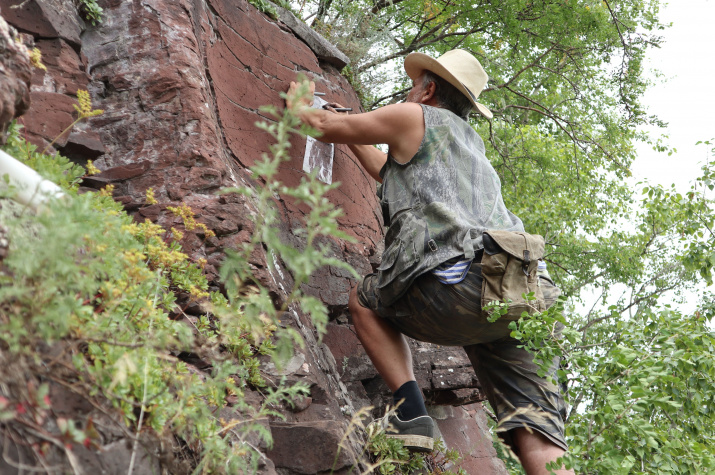An expedition within the framework of the "Preservation and popularization of the cultural heritage of Shalabolinskaya Pisanitsa» project of the Russian Geographical Society was completed in the Krasnoyarsk Territory.
This project of the Krasnoyarsk regional branch won the contest of the Presidential Grants Fund, which allowed organizing the necessary works.
The participants were students and teachers of Astafyev Krasnoyarsk State Pedagogical University, researchers from the Krasnoyarsk and Minusinsk museums of local lore, Khakass Research Institute of Language, Literature and History, Krasnoyarsk geoarchaeology Lt and the«Archaeological Design and Research» Scientific and Production Association.
"During the work the entire mountain range of the Pisanitsa was surveyed for about 3 kilometers and around 300 planes with rock paintings were discovered: they were performed with ocher in the technique of embossing, engraving and rubbing. More than 30 of these paintings are new planes, and more than 100 petroglyphs on them have not been previously discovered. The time range of the images is quite wide: about 9 thousand years (from the Stone Age to the Ethnographic Modernity).There are images of animals (elks, marals, goats, bears, boars, bulls, horses, etc.) as well as those of people shown in boats, on horses, on skis; scenes of hunting, battle, religious rituals are often illustrated too. Of special interest are paintings of mythical predators and fantastic images in the form of masks that were performed 4 thousand years ago", said Alexander Zaika, the scientific leader of the expedition, one of the most famous specialists on Shalabolinskaya Pisanitsa, a historian and teacher of Krasnoyarsk State Pedagogical University.
According to scientists, more than a thousand petroglyphs are found on the unique Pisanitsa in the Kuraginsky district of the Krasnoyarsk Territory.
The expedition is the first stage of the project to save Shalabolinskaya Pisanitsa. In the near future, the study of the materials received will begin to prepare a research report.
At the second stage, a single information base for Shalabolinskaya Pisanitsa rock drawings will be created.
"The obtained data will help to develop recommendations for the preservation of the most problematic areas of this location." Unfortunately, many drawings and compositions were preserved fragmentarily because of weathering of rocks, others were spoiled by modern inscriptions of visitors. Restoration works are required. Otherwise, we risk losing this unique monument to the ancient history and culture of our region", said Alexander Zaika.
It is assumed that the received materials will allow to start restoration woks in the coming years, and at the same time the process to create an open-air museum on the basis of Shalabolinskaya Pisanitsa will be initiated.
As Krasnoyarsk scientists think, Shalabolinskaya Pisanitsa still has many secrets, because according to their data, there are other planes with unique petroglyphs under the rocky talus.
In addition, the Tuba river washing Pisanitsa has caused a layer of soil over the millennia, so the scientists are sure to face new discoveries.











